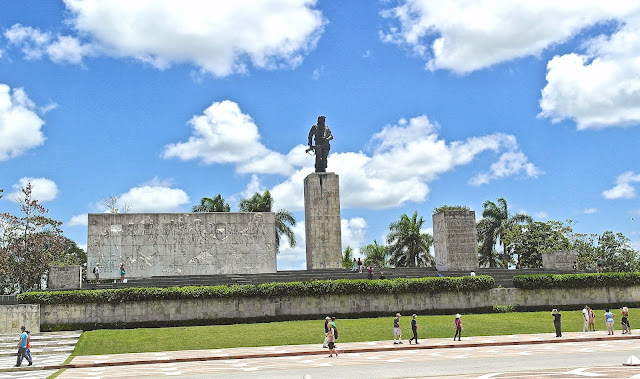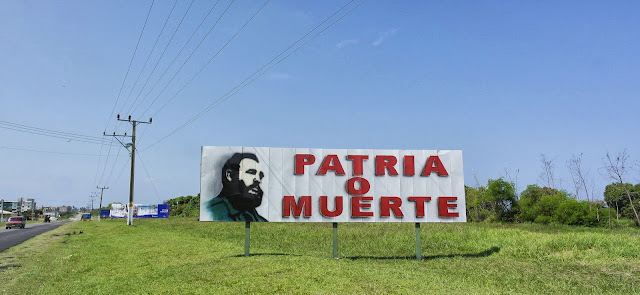Some time back, in Berlin, me and some friends stopped by a small shop selling clothing and props from the Soviet Union era. My friends bought some stuff with red stars, decorated with hammer and sickle and other symbols. My friend from Lithuania, a former Soviet republic, didn't buy anything (me neither). He told me later that many Lithuanians still would feel offended by people wearing such symbols. Many Lithuanians still remember Soviet suppression. He asked if I would wear clothes with swastika or other Nazi symbols. I answered "Of course not!", but I was surprised by the question. I also told him that I had not thought of it this way before....
I later visited Cuba, a state which still hang on to communism and still hail the socialist revolution back in 1959. Fidel Castro was the main leader of the Cuban guerrilla back then and he is still alive. The power is now given to his younger brother Raul since 2008. According to the leaders on Cuba, the revolution still lives. Murals, signs, posters and billboards on buildings and along the roads try to make sure that Cubans don't forget that.
 |
| Fidel Castro (right) and his less charismatic brother Raul Castro (left) says: "Go Ahead!" |
The propaganda machine on Cuba have been persistent, and have made Fidel Castro’s friend and war commandant Ernesto Guevara de la Serna, or Che Guevara as we call him, into an internationally famous and iconic figure. His portrait is all over Cuba, in schools, public buildings and his main monument is at the plaza de la revolucion in Santa Clara.
 |
| An enormous Che Guevara statue at the "plaza de la revolucion" in Santa Clara, Cuba |
 |
| Che Guevara on the wall of the ministry of communication in Havana |
Che Guevara (the Argentinean) left Cuba in 1965. His mission was to spread the revolution all over South America, and he died as a guerrilla soldier in Bolivia in 1967.
 |
| Che Guevara in Cienfuego "Your example lives, your ideas stays" (something like that) | |
There is a connection between street art and ideological propaganda. When the french stencil and street artist Blek Le Rat was a child, he travelled to Italy with his parents where he saw wall stencils which depicted Mussolini. This experience became a part of his inspiration to begin with stencil making in the streets. However, with a quite different attitude and ideological basis. Blek Le Rat first stencils where his black rats. The street artist Shepard Fairey (obeygiant) use the strategies of propaganda (easy recognizable pictures, often two or three colors, with short slogans) as part of his artistic project and participation in social movement campaigns. The advantage of stencils lies in its symbolic character, often black and white, and is easy to distribute and repeat with limited resources. The Che Guevara stencil is iconic, known all over the world and lives its own life, transcending any real historic and original ideological meaning of his ideas and life (except maybe on Cuba).
 |
| Fidel Castro Says: "Fatherland or death" |
Propaganda often
presents facts selectively and uses loaded messages to produce
an emotional rather than rational response. Propaganda can be used as a form of ideological or
commercial warfare. On Cuba, propaganda is still an agent trying to influence peoples attitudes and values, but the power of the propaganda is vanishing day by day for most people. It's important to see that propaganda strategies is not just means of dictators or ideological systems. In the "free world" we often use the word "campaign".
 |
| Street sign outside Cienfuego with clear reference to the U.S. supported invasion failure at the bay of pigs in 1961 |
One day signs like these, depicted above, probably will be replaced by commercials for beer, burgers or perfume etc. In Germany, the old nazi symbols are still prohibited by law for good reasons and all over the world these symbols are loathed by the large majority. So why haven't the same happened with communist and socialist propaganda and symbols?
I don't have the answer to that, but parts of it may have something to do with the historical roots of many revolutions and parts about how the socialist systems fell. The raise against the social and economical brutality of the Batista regime had sympathy in Europe. After the horrors of world war II, fascist, military, racist and ultraconservative regimes were regarded worse than socialist regimes (which after all, at least on paper, had an ideology of making things better for all). In addition, U.S. and European democracies weren't perfect either. When the Berlin wall fell in 1989, people where just happy to gain freedom and the old system that had failed in so many ways was replaced without a massive war to break it down. The notion of the socialistic society was over, and communism had failed. All that was left was the cultural artifacts and the symbols. There were no "propaganda power" left in them for most people, both inside and outside of the wall. Just an aesthetic value from a political system that actually died from within.







